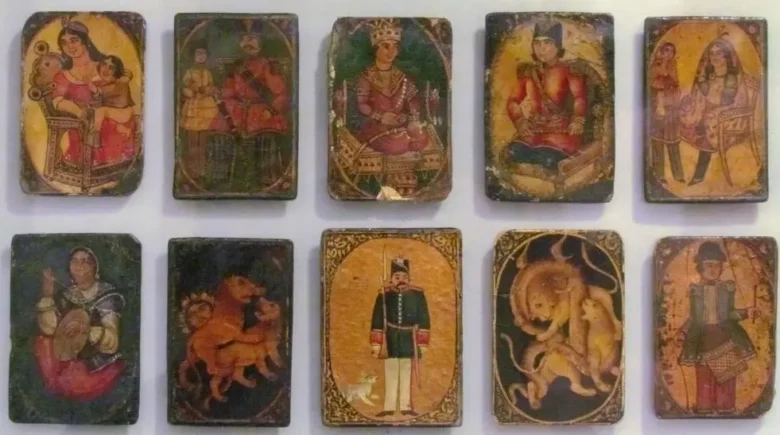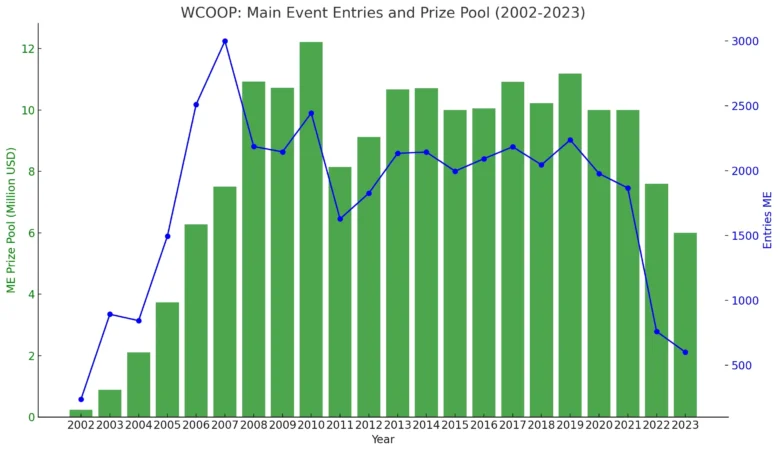The Evolution of Poker


- Fact Checked by: PokerListings
- Last updated on: June 10, 2025 · 15 minutes to read
Poker has a long and tangled history, with roots in ancient card games. According to Robert Frederick Foster, as stated in his book Foster’s Complete Hoyle (1937), the game dates back to the 17th-century Persian game As-Nas. In this article, we explore the history of poker, the evolution of online poker, its current state, and future prospects. (1)
Table of Contents
The Origins of Poker as a Game
To begin, let’s compare modern poker with As-Nas, a game played hundreds of years ago. As-Nas used miniature hand-painted cards (approximately 4×6 cm), without suits or ranks. The highest card — the “As” — featured an animal, while the remaining cards — “Nas” — depicted human figures. Players formed familiar hands such as pairs, two pairs, and full houses using a 20–25 card deck. Surviving examples of As-Nas cards can be found at the Brooklyn Museum, the Metropolitan Museum, and the British Museum. (2)

While As-Nas shares similarities with modern poker rules, even earlier in Europe, there were games like “Poch” (German version) and “Poque” (French version), which may also be considered predecessors to poker. The earliest known instances date back to 1441 in Strasbourg.
These games used a 32- or 52-card deck and included betting, bluffing, and hand ranking — elements later adopted by poker. The gameplay unfolded in three stages: deal, betting round, and trick-taking. A unique feature of Poch was the presence of a special board with marked sections for bets and winnings. (3)
Meanwhile, the UK developed its own card traditions. The 1721 edition of The Compleat Gamester included rules for “Brag,” which closely resembled “Post and Pair,” a game dating back to 1528. The classic version used a 52-card deck, and the goal was to form a three-of-a-kind, a pair, or a three-card straight.
Brag made its way to North America with English settlers and was described in Hoyle’s Games Improved in 1825. (4)
It’s likely that Brag became the direct predecessor of poker, which developed and gained popularity in the U.S. during the 19th century — borrowing traits from many of its historical predecessors.
According to The Oxford Guide to Card Games, playing cards first appeared in China, already using four suits. In Europe, card games were played as early as 1371, possibly originating not from Chinese cards but from Egyptian ones that spread via Turkey. Egyptian cards had four suits, ten numbered cards, and three face cards. These suits were gradually transformed in Italy and France, and the “French suits” — the ones we use today — emerged around 1480. (5)
As-Nas, Poque, Brag, and their forerunners were all stepping stones on the path to modern poker. In each region, games involving betting, bluffing, and card combinations evolved independently. But it was 19th-century America that combined all these elements into the game we recognize today.
What Kind of Poker Was Played in the Wild West?
The center of poker’s development was the saloons of the Wild West — dark, smoky halls where fortunes were lost and destinies decided. One of the most iconic stories of this era is the tragic death of Wild Bill Hickok, who was shot in the back of the head during a poker game. At the time, he held 8♣ A♠ A♣ 8♠ — a hand now known as the “Dead Man’s Hand.” And as you’ve probably guessed, they weren’t playing Texas Hold’em, where players only hold two hole cards.
So what kind of poker were the cowboys actually playing? The most common games in saloons were Five-Card Stud and Five-Card Draw. There were no blinds, just antes, and hands like straights and flushes didn’t yet exist — they were introduced after the Civil War. This early form of poker remained dominant until the 1940s, when 7-Card Stud emerged in the U.S. and became the go-to game for both amateurs and professionals — right up until the World Series of Poker popularized Texas Hold’em and, later, Omaha. (5)
The Birth of the WSOP
By the mid-20th century, poker had become popular across the U.S. If you knew where to look, you could find high-stakes games. In 1949, Johnny Moss played a legendary heads-up match against Nick “The Greek” Dandolos that lasted five months. The match was arranged by casino owner Benny Binion, and it ended with a line that became part of poker lore:

“Mr. Moss, I have to let you go.”
But most poker action still happened underground. Professional players traveled from state to state in small groups, looking for good games. These games were often hosted in bars, and it wasn’t uncommon for players to be robbed or denied their winnings. Doyle Brunson once recalled on Twitter that during a game in Fort Worth, a man approached the table with a gun and shot another player in front of him:
My 1st year as a pro, I was playing in a pool hall on the stockyards when a man came in and shot a player. His brains seemed to splatter all over the wall. We all ran out the back door to keep from talking to cops. We had to go through a cold, cold creek. https://t.co/GuDErYSpmH
— Doyle Brunson Legacy (@TexDolly) May 21, 2020
In the 1960s, poker began to appear in casinos, but its development was driven by enthusiasts trying to bring together amateurs and traveling pros. In 1969, in Reno, Nevada, the owner of the Eldorado Club and Hotel Apache — Tom Moore — teamed up with poker enthusiast Crandell Addington to host a gathering called the “Texas Gamblers Convention.” Moore hoped players would spend time and money in the club, especially on drinks, but they stayed glued to the tables and barely bought anything. Addington won the event, and Moore chose not to repeat the experiment.
The idea was picked up by Benny Binion, who had organized the 1949 Moss–Dandolos match. With Moore’s permission, Binion hosted a poker gathering at his own casino, Binion’s Horseshoe. The players included Johnny Moss, ‘Amarillo Slim’ Preston, Bryan ‘Sailor’ Roberts, Doyle Brunson, Walter ‘Puggy’ Pearson, Carl Cannon, and Addington. This event would go down in history as the inaugural WSOP 1970 — the first “series,” despite the fact that there was no tournament structure yet.

The format was simple: players played various poker games, and then voted on who was the best. According to legend, the first vote was inconclusive because each player voted for himself. So a second round was held — this time voting for the best player other than yourself — and Johnny Moss was declared the winner. While some details of this story remain unverified, all sources agree Moss was crowned the best.
The tournament format was introduced the following year, 1971, after Walter ‘Puggy’ Pearson pitched the idea of a freezeout structure to Binion. Binion liked it so much that he implemented it right away — WSOP 1971 became the first official poker tournament series, and Moss again won the Main Event.

Poker legends Johnny Moss and Jack Binion, pivotal figures in launching the WSOP in 1970.
Over the following decades, WSOP evolved into the world’s most prestigious poker event. Many ideas that now seem standard were actually introduced over time — often by chance.
In 1979, Benny Binion created the Poker Hall of Fame to link legendary players to his casino and preserve the history of the game.
In 1982, tournament director Eric Drache came up with the concept of satellites — by chance. He noticed that a group of players had taken over a cash table and, instead of removing them, suggested they each go all-in and the winner join the WSOP Main Event. The idea caught on and revolutionized poker. (6, 7)
The First Online Poker Sites
By the early 2000s, poker was regularly featured on television, and the internet was spreading rapidly. The idea of moving card games online emerged almost simultaneously among several developers. In 1998, only 3.6% of the world’s population had internet access, but the market was beginning to take shape. One of the first places people encountered online poker was through IRC, where early adopters and future founders of poker sites played text-based games.
The first real-money online poker room was Planet Poker, launched on January 1, 1998. The software was buggy and unstable, but it marked the beginning. In October 1999, the site appointed well-known poker author and theorist Mike Caro as its ambassador. The games were primarily Limit Texas Hold’em, with low stakes up to $5/$10. No-Limit Hold’em was still a rarity. (8)

In 1999, Paradise Poker entered the market and quickly overtook Planet Poker thanks to better graphics, smoother software, and an intuitive interface. Based in Costa Rica, the room operated outside U.S. jurisdiction. By the early 2000s, Paradise Poker became the gold standard, until it was hacked in 2004 and later acquired by Sportingbet.
Then came the real giant. In 2001, PartyPoker launched, created by PartyGaming (founded in 1997). With targeted marketing, a focus on U.S. players, and a stable platform, PartyPoker quickly dominated the scene. It remained the largest online poker room until 2006.
The growth of online poker mirrored global internet usage:
- 1999 → 4.1% of the world online
- 2001 → 8.6%
- 2006 → 16.7%
According to Christiansen Capital Advisors, online poker revenues grew from $82.7 million in 2001 to $2.4 billion in 2005. (9, 10)
The Moneymaker Effect
Although PartyPoker led the industry in the early 2000s, new rooms continued to emerge with fresh strategies. One of the most influential was PokerStars, launched in 2001 by Isai Scheinberg, a former IBM developer from Toronto. After failing to sell his poker software to bigger companies, he launched the site with his son, Mark Scheinberg. (11)
From the beginning, PokerStars focused on ambassadors and sports-like branding. In 2003, the platform hosted a now-legendary online satellite that sent an unknown accountant from Tennessee — Chris Moneymaker — to the WSOP Main Event.
Inspired by the film Rounders (12), Moneymaker qualified for the $10,000 buy-in tournament through a $50 online satellite. According to his account, he was ready to sell his seat for $8,000 but was convinced to play. He borrowed $4,000 to cover travel costs and made his way to Las Vegas.
Against all odds, Moneymaker won the WSOP Main Event, defeating seasoned pros and taking home $2.5 million. He became the poster boy for the “American Dream” in poker — an ordinary guy who beat the best thanks to online play. PokerStars quickly signed him as an ambassador — a partnership that lasted 17 years, a record in the poker world.

His win sparked what’s now known as The Moneymaker Effect (13), igniting a global boom in poker. In 2004, another online qualifier, Greg Raymer, won the Main Event after entering through a $160 satellite.
Main Event attendance exploded: (14)
- 2003 → 839 entrants
- 2004 → 2,576 (+207%)
- 2005 → 5,619 (+118%)
- 2006 → 8,773 (+56%)

The peak came with Jamie Gold’s 2006 victory. Poker became mainstream. TV broadcasted tournaments, and millions of players tried online poker for the first time, driven by this online-to-live success story.
UIGEA and the U.S. Market Crash
Until 2006, PartyPoker remained the dominant force in online poker, holding the title of the world’s largest poker site. But that fall, a legislative bombshell dropped: the 109th U.S. Congress passed the Unlawful Internet Gambling Enforcement Act (UIGEA), embedded in the SAFE Port Act, which was originally about port security. (15)
UIGEA did not explicitly ban online poker, but it prohibited financial institutions from processing transactions related to unlicensed online gambling. Since only Nevada issued gambling licenses in the U.S. at the time, most operators found themselves operating illegally. (16)
As a publicly traded company listed on the London Stock Exchange, PartyPoker had no choice but to withdraw from the U.S. market immediately. The loss of a massive player base forced the company to shift focus to Europe, but the damage was done. PokerStars took over the number one spot.
Unlike PartyPoker, PokerStars and Full Tilt Poker, both privately held, decided to stay in the U.S. despite the legal uncertainty. PokerStars emphasized mass-market tournaments, while Full Tilt marketed itself with charismatic high-stakes pros and edgy branding. From 2006 to 2011, these two titans battled for dominance.
But the legal risks caught up.
April 15, 2011 — Black Friday
The U.S. Department of Justice seized domains, froze accounts, and unsealed indictments against PokerStars, Full Tilt, and Absolute Poker. Investigations revealed Full Tilt had used player deposits for operations and was nearly $390 million short in player balances.

In 2012, PokerStars settled with the DOJ: (17)
- It acquired Full Tilt Poker (18)
- Repaid affected players
- Isai Scheinberg stepped down and handed the company to his son Mark
- The company avoided prosecution by exiting the U.S. market
In 2014, Isai Scheinberg sold PokerStars to Amaya Gaming for $4.9 billion. In 2020, he pled guilty to U.S. gambling violations and paid a $30,000 fine. (19, 20)
In late 2020, Scheinberg gave a rare interview detailing the company’s decision to stay in the U.S., how Black Friday unfolded, and the aftermath. (21)

The Impact of Black Friday
Black Friday shocked the poker world. Overnight, leading sites lost access to their biggest market. Thousands of players lost accounts or funds. The industry’s reputation suffered a major hit. What once seemed like a legitimate online counterpart to casino poker now looked fragile and risky.
The Main Event at the WSOP drew 7,319 players in 2010 — a level not surpassed until 2018. (22)
The ripple effect was severe. High-stakes TV games like High Stakes Poker and Poker After Dark disappeared. Prize pools shrank, ambassadors lost contracts, and major tournaments plateaued.
A good example is WCOOP, PokerStars’ flagship online series. In 2010, it hit record participation. In 2011, numbers plummeted, and the record stood unbroken until 2023. Without U.S. players and the associated marketing, the community deflated. (23)

Online poker didn’t die — but it regressed. Rebuilding trust and infrastructure took nearly a decade. The industry became cautious, wary of regulators, player skepticism, and external shocks.
The Modern Era
After Black Friday, the online poker industry entered a period of stagnation, which hit the market leader PokerStars particularly hard. The room underwent ownership changes, lost key staff members, and had to adapt to increasingly strict European regulations. While PokerStars continued to host large live tournaments, its online product steadily lost ground. It introduced Fast Fold formats (inherited from Full Tilt Poker) and fast-paced lottery-style Spin&Go tournaments—an answer to Winamax’s successful Expresso format in France. But the market was waiting for something new.
That new impulse came from Asia. In 2014, GGPoker was launched, initially targeting the Asian market but quickly attracting players in Europe as well. Unlike PokerStars’ reserved and minimalist client, GGPoker offered a colorful, gamified interface: with emojis, animations, and item-throwing interactions between players. The platform’s strategy mirrored the glory days of Full Tilt Poker—emphasis on high-stakes action, strong ambassadors, and aggressive marketing. Online poker began to feel like a show again.
In fact, GGPoker echoed some key elements of Full Tilt Poker in its prime. It focused heavily on high-stakes games and signed successful players, not sport stars, to promote the brand. Final tables of major tournaments began to display players’ real names, bringing online poker closer to the experience of live games.
A symbolic moment came on November 20, 2019, when one of the most recognized faces in poker—Daniel Negreanu—left PokerStars to join GGPoker. His decision marked a turning point and the beginning of a new era. PokerStars was losing its identity, and GGPoker was gaining one.
I have a BIG announcement to make! Details in the video below: pic.twitter.com/1xDTkglYmD
— Daniel Negreanu (@RealKidPoker) November 20, 2019
Soon after, GGPoker began setting records and cementing its status as the industry’s new leader. On October 28, 2020, the room made Guinness World Records history by hosting the largest online poker tournament prize pool ever: $27,559,500. This was, of course, tied to the hosting of WSOP Online during the COVID-19 pandemic. (24)

Covid-19
During the COVID-19 pandemic, many people found themselves stuck at home with their computers, leading to a new wave of online poker popularity. Numerous events that were previously held in brick-and-mortar casinos moved to online platforms. WSOP was no exception—parts of the series transitioned online, marking a major shift in the 50-year history of the World Series.
GGPoker capitalized on this momentum to strengthen its position. On August 1, 2024, the brand’s parent company, NSUS, announced it had acquired the rights to the WSOP from Caesars Entertainment for $500 million. The agreement includes a provision that the main WSOP series will continue to be held at Caesars-owned casinos in Las Vegas for the next 20 years. (25)
Today, GGPoker is more than just the largest online poker site. It holds the rights to WSOP, it’s the dominant force in the industry, and it’s the face of a new era. But how long will this dominance last? What could shake up the current status quo—and where might the next poker revolution come from?
Hypotheses about the Future of Poker
June 2025. Online poker is alive, but the industry is tense. Formally, the market is recovering: the audience has stabilized, brands have resumed marketing efforts, and TV shows are once again talking about poker. But underneath it all lies instability.
In Europe, regulation is tightening. Almost every market requires a local license. Segmentation, taxes, time restrictions, advertising limitations. GGPoker is still adapting successfully, but growth is slowing.
In the United States, legalization has been ongoing for ten years. States are gradually signing agreements with each other, forming the Multi-State Internet Gaming Agreement (MSIGA). But the process is slow, and the market remains fragmented.
Simultaneously, a parallel ecosystem is forming in the U.S. market — sweepstakes poker. GlobalPoker has proven the viability of the format, and now new players like Stake are entering the space. Given Stake’s creative marketing and aggressive presence in the crypto world, this model could become a viable alternative to traditional online poker.
Technological threats are growing. The bot problem has existed for two decades, but the rise of public AI systems has made it even harder to detect unfair play. Most of the industry is now investing in detection algorithms and manual moderation. Poker rooms are striving to integrate technology in ways that eliminate any advantage from exclusive access to advanced tools. GGPoker has already introduced a HUD with opponent data; now the next step is for poker rooms to incorporate AI coaching systems based on individual player histories.
Amid global challenges, poker shows are making a comeback. The Triton series offers a perfect mix — high stakes, personal brands, action.
Let’s not forget the potential of emerging markets that have been underrepresented in online poker until now. Latin America, Africa, and India could all become new frontiers for growth.
The question is not whether online poker will survive — it will. The real question is: in what form? Will GGPoker maintain its leadership? Will a new giant emerge in the U.S. through next-generation sweepstakes platforms? Will Twitch and Netflix revive poker shows comparable to Poker After Dark?
-
- 100% up to $2000
T&Cs Apply | Play Responsibly | GambleAware
18+ | Play Responsibly | T&C Apply
-
CoinPoker4.1
- 33% Weekly
- 150% up to 2000$
T&Cs Apply | Play Responsibly | GambleAware
+18 / T & C apply / Play responsible
-
Stake.US Poker4.3
- Rakeback 5%
- $55 Stake Cash + 260K Gold Coins
T&Cs Apply | Play Responsibly | GambleAware
18+ | Play Responsibly | T&C Apply
-
- 100% up to $1000
T&Cs Apply | Play Responsibly | GambleAware
T&Cs Apply | Play Responsibly | GambleAware
-
T&Cs Apply | Play Responsibly | GambleAware
18+ | T&Cs Apply | Play Responsibly | GambleAware


